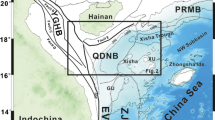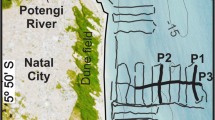Abstract
High resolution seismic profiles from the Canadian Beaufort Sea continental slope characteristically show a surficial 50 m thick conformably stratified unit overlying an irregular erosion surface. This stratified unit appears to be compressionally folded and associated with minor faults. At the shelf break, there are numerous indicators of a tensional regime, such as a large, slope-parallel graben and numerous mud diapirs. Although a large-scale slide-scar was mapped in one area, most of the slope is interpreted to be deforming by a creep mechanism. Preliminary calculations can provide reasonable values for the fold wave length and rate of deformation, supporting the suggestion that time dependent creep deformation has occurred in this area.
Similar content being viewed by others
References
O'Connor, M. J., 1981. Morphology of the shelf edge. A report on the southern Beaufort Sea. Unpublished report for the Geological Survey of Canada. M. J. O'Connor and Associates Ltd., Calgary, Alberta, 70 p.
Davies, K. F., 1975. Mackenzie River input to the Beaufort Sea. Beaufort Sea Project, Technical Report 15, Institute of Ocean Sciences, Sidney, British, Columbia, 72 p.
MacKay, J. R., 1963. The Mackenzie Delta area, Northwest Territory. Geographical Branch, Department of Mines and Technical Surveys, Ottawa, Memoir 8, 202 p.
Harper, J. R. and Penland, S., 1982. Beaufort Sea sediment dynamics. Unpublished Report for the Geological Survey of Canada. Woodward-Clyde Consultants, Victoria, British Columbia, 125 p.
Pierce, J. W., 1976. Suspended sediment transport at the shelf break and over the outer margin. In: D. J. Stanley, and D. J. P. Swift (eds.), Marine Sediment Transport and Environmental Management. John Wiley and Sons, New York, p. 437–458.
Lemon, D. D., and Lowalski, D. M. 1982. Water column measurements at Canmar drill sites in the Beaufort Sea, 1976–1980. A Data Report. Unpublished report to Ocean Information Division, Institute of Ocean Sciences, Sidney, British Columbia Arctic Sciences Ltd., 222 p.
Berryhill, H. L., 1981. Geologic processes and sea floor stability, continental shelf and slope, Northwest Gulf of Mexico—A systematic approach to identifying, hazards. American Association of Petroleum Geologists, Education Course Note Series No. 18, p. 4A: 1–98.
Morgenstern, N. R., 1967. Submarine slumping and the initiation of turbidity currents. In: A. F. Richards (ed.), Marine Geotechnique. University of Illinois Press, Urbana, p. 189–220.
Bishop, A. W., and Lovenbury, H. T., 1969. Creep characteristics of two undisturbed clays. Proceedings Seventh International Conference on Soil Mechanics and Foundations Engineering, v. 1, p. 29–37.
Watkins, D. J., and Kraft, L. M., 1978. Stability of continental shelf and slope off Louisiana and Texas: Geotechnical aspects. In In: A. H. Bouma, G. T. Moore, and J. M. Coleman (eds.), Framework, Facies, and Oil Trapping Characteristics of the Upper Continental Margin. American Association Petroleum Geologists Studies in Geology No. 7, p. 267–286.
Ramsey, J. G., 1967. Folding and Fracturing of Rocks. McGraw-Hill, New York, 568 p.
Ramberg, H., 1964. Selective buckling of composite layers with contrasted rheological properties: a theory for simultaneous formation of several orders of folds. Tectonophysics, v. 1, p. 307–341.
Salmon, C. G., and Johnson, J. E., 1971. Steel Structures: Design and Behaviour. Intext Educational Publishers, New York, 946 p.
Ter-Stephanian, G., 1963. On the long-term stability of slopes. Norwegian Geotechnical Institute, v. 52, p. 1–14.
Ter-Stephanian, G., 1975. Creep of a clay during shear and its rheological model. Geotechnique, v. 25, p. 299–320.
O'Connor, M. J., 1982. An evaluation of the regional surficial geology of the southern Beaufort Sea. Unpublished report for the Geological Survey of Canada. M. J. O'Connor and Associates Ltd., Calgary, Alberta, 188 p.
Almagor, G., 1967. Interpretation of strength and consolidation data from some bottom cores off Tel-Aviv-Palmakhim coast, Israel. In: A. F. Richards (ed.) Marine Geotechnique. University of Illinois Press, Urbana, p. 131–153.
Author information
Authors and Affiliations
Rights and permissions
About this article
Cite this article
Hill, P.R., Moran, K.M. & Blasco, S.M. Creep deformation of slope sediments in the Canadian Beaufort Sea. Geo-Marine Letters 2, 163–170 (1982). https://doi.org/10.1007/BF02462758
Received:
Revised:
Issue Date:
DOI: https://doi.org/10.1007/BF02462758




